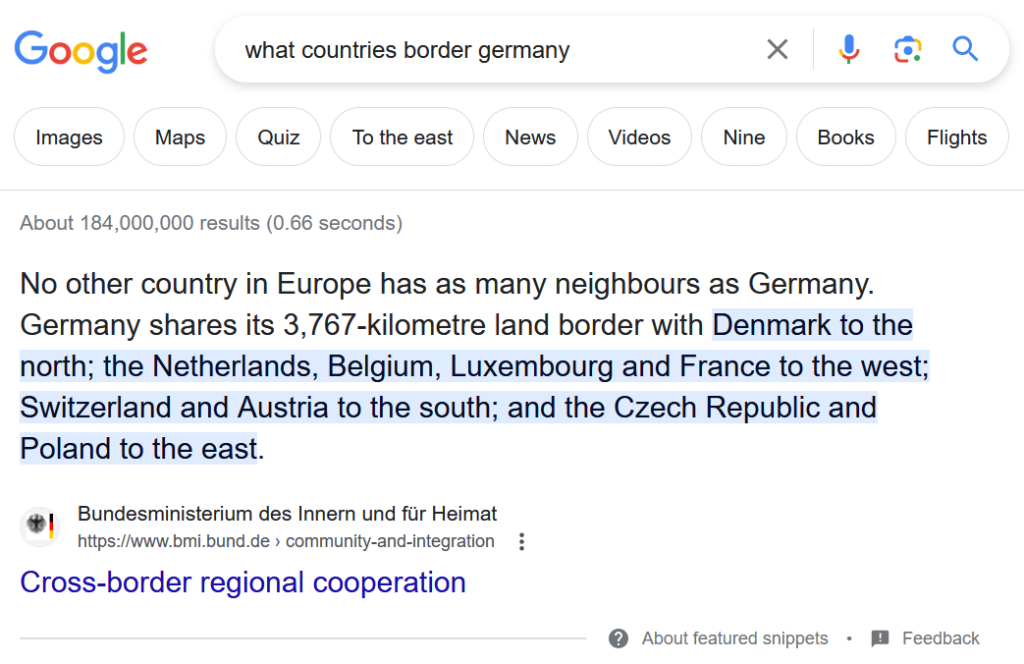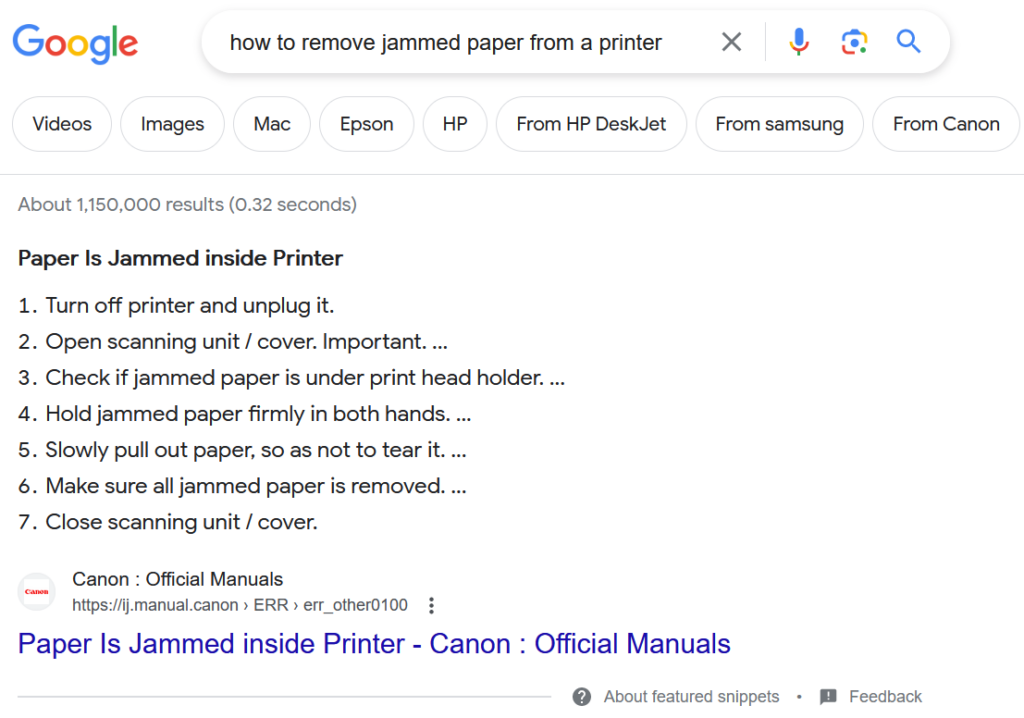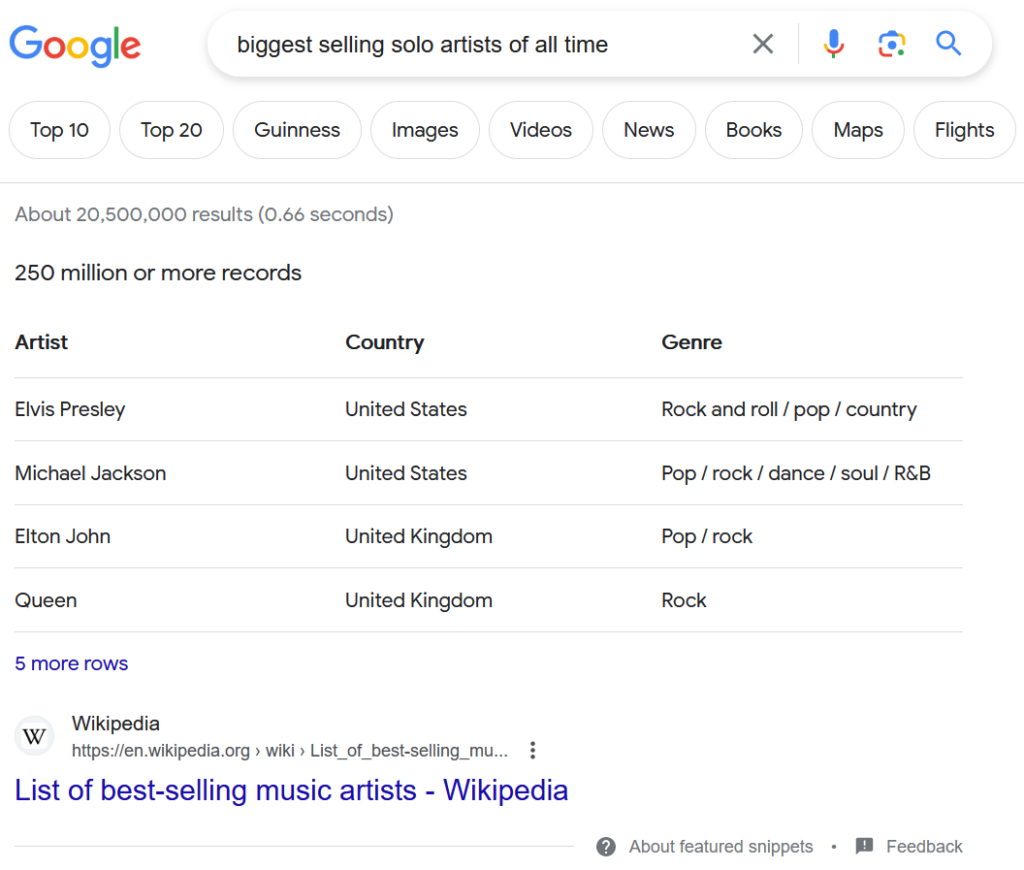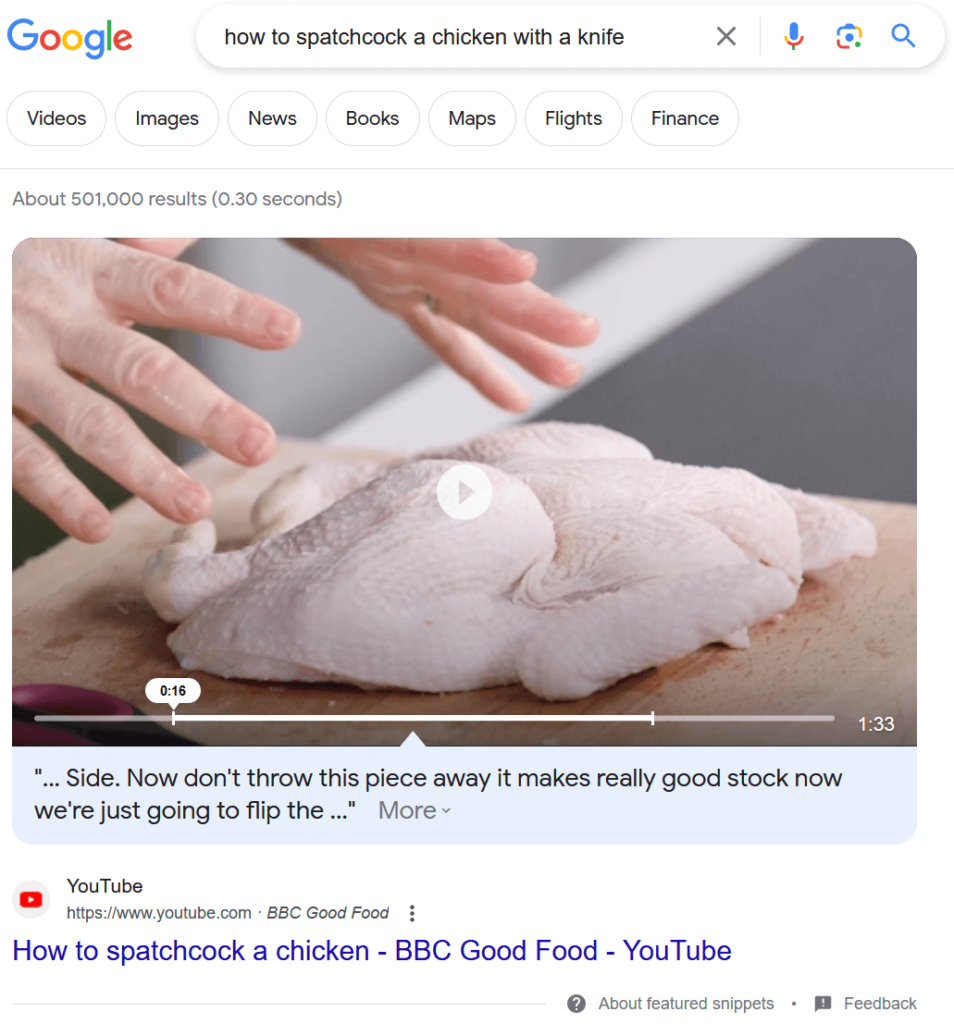Time is arguably our most important commodity, so anything that saves us time is a winner.
Featured snippets are Google’s way of saving a user time by delivering the exact excerpt of information they are looking for.
If a user searches for ‘What countries border Germany?”, Google won’t simply provide a list of websites for the user to sift through where this question is answered. Instead, it will provide a featured snippet to concisely answer the question. This is obviously hugely beneficial to users, but it can also be used to the advantage of website owners and developers.
Featured Snippets in a Snippet
A featured snippet is a concise summary or answer to a user’s query that appears at the top of SERPs.
It is designed to provide a quick and direct answer to the user’s question without requiring them to click on any search results.
Who Makes Featured Snippets?
The featured snippet isn’t a response formulated by Google. It’s an extract pulled from a webpage that Google previously indexed.
The snippet can be taken from any part of a webpage, and it can take the form of a paragraph, a list, a table, or a video.
You can’t create one, as such. The best thing you can do as a content creator is produce content that your audience will find helpful, and keep your fingers crossed that Google selects it as a featured snippet.
The Importance of Featured Snippets
The featured snippet appears at the very top of the search engine results page, in a spot commonly known as position zero.
To hit this spot on SERPs ordinarily, you’d need to occupy the top-ranking position for the user’s query.
Any SEO professional knows this is much easier said than done.
However, if you can get your content selected for a featured snippet, you can bypass the ranking algorithms. By appearing at the top of the SERPs, your website is likely going to benefit from a spike in traffic, and these users can potentially be converted to customers or newsletter sign-ups.
Types of Featured Snippets
Paragraphs
Paragraphs are the most common type of featured snippet on Google. In this type of snippet, a whole paragraph will be pulled from a webpage that Google deems to most accurately answer the user’s query. The specific information related to the query will be highlighted or presented in bold to make it easier for the user to scan.

Lists
Featured snippets commonly appear in list form if a query is best answered in numbered steps, or if a bulletpoint list makes more sense.

Tables
For queries that involve data or comparisons, Google may present a featured snippet in the form of a table. This provides more structured information to the user that’s more efficient to decipher compared with the same information in paragraph form.

Videos
Videos are becoming increasingly popular as featured snippets, which is no surprise given that YouTube is one of the biggest search engines on the planet. This is particularly relevant for queries related to tutorials and demonstrations.

Getting Selected for Featured Snippets
There’s no quick and easy way to get your content chosen for a featured snippet, but there are ways you can increase the likelihood of this. Consider these recommendations:
Optimise for Voice Search
Featured snippets are used by virtual assistants such as Siri and Alexa to answer users’ voice searches.
Optimise your content to make it more relevant to voice searches, which typically use more casual language.
For example, when a user types a search query into Google they might input ‘oldest reptile’. When a user utilises voice search, they are more likely to say “what is the oldest reptile in the world?”. By optimising your webpage for casual long tail keywords like this, while providing clear and concise answers, you increase your chances of being used as a featured snippet.
Format Your Content
Content that has been organised into clear sections of lists, tables, or instructions is easier for Google to understand, and easier for users to scan.
By formatting your content into concise snippets, it is more likely to be used as a featured snippet.
Create User Guides
Where possible, create how-to guides or tutorials that address common user queries relevant to your content.
Google often looks for step-by-step instructions when selecting content for featured snippets, in the form of numbered lists, bullet points, or videos.
Use Structured Data
Data markups give search engines more information about your content and put it into context.
Use structured data to markup as much of your content as possible to make it more attractive to Google as a featured snippet.
Remain Current
Regularly update your content to ensure that it remains accurate and relevant.
Search engines are more likely to choose content that is up-to-date and reflects current information.
Write Accurately
Featured snippets aren’t interested in your opinion. They are there to provide concise, accurate answers to a user’s question.
To improve your chances of getting one, be sure to create content that is factual, accurate, and easy to digest. Avoid excessively long sentences, opinions, conjecture, and false claims.
Use Meta Tags
Compelling meta titles and descriptions that accurately represent the content on your page help search engines understand the relevance of the page. Clear and relevant title tags and meta descriptions can increase the likelihood of being chosen for a featured snippet.
Research Keywords
Not all search queries result in a featured snippet.
To find your website being used for a featured snippet, you first need to find out what sort of search queries get one, and then create content that corresponds to this type of query.
Read also: Keyword Research: Revealed and Refined
Typically, you need to get as specific as possible. Meaning that you should focus on long tail keywords.
Here, we can see that the search query ‘how to make curry’ does not get a featured snippet, while ‘how to make slow cooker curry thicker’ does get one. Aim to answer specific questions to get your content chosen.
To Wrap Things Up
Getting a featured snippet is like getting an award of recognition from Google, and it’s certainly something to aspire towards and something to be celebrated when you achieve it.
While there’s no way to guarantee that information from your website will be used as a featured snippet, there are several ways you can boost your chances.
If structured data and meta tags have got your head in a spin, you can alleviate the dizziness by handing over your SEO to a pro.
Contact us to see how we can help.
- Canonicalization: The Dos and Don’ts of Canonical Tags - May 27, 2024
- On-Page SEO: The Ultimate Guide - May 25, 2024
- The Only WooCommerce SEO Tutorial You Need in 2024 - May 23, 2024